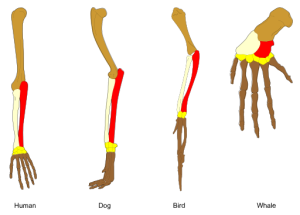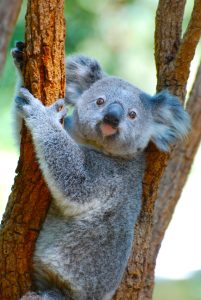9 Classification
Tori M Saneda
Classification: Ordering the Natural World
As we learned in Unit 1, Carolus Linnaeus developed what is known as the Linnaean system of classification. This basic system is still used today, although it is focused on illustrating evolutionary relationships between organisms. This may sound familiar and it should—think phylogentic tree! Now we take a moment to look in more depth at classification.
Why do we bother with classification systems? Classification systems are important to help scientists organize the massive diversity of the natural world. It’s a method that helps scientists from different countries talk about the natural world without confusion. Modern classification is considered a natural system representing real relationships between organisms. One thing to keep in mind when looking at classification systems is that it is basically a hypothesis about evolutionary relationships between species, which is why you may see different schemes as researchers may interpret data differently.
The Linnaean System
This hierarchical system organizes organisms into ever increasingly similar categories. Linnaeus’ system was originally published in Systema Natura in 1735. He published ten editions of the book, adding new levels to the hierarchy in subsequent editions. He used comparative anatomy to create his categories, focusing particularly on the structure and function of body parts (Scoville 2019).

Since Linnaeus published, the classification system has been modified using evolutionary relationships. There are eight main levels: Domain, Kingdom, Phylum, Class, Order, Family, Genus, Species (Scoville 2019). Using the modern system, humans are classified as:
| Category | Level | Common Characteristics |
| Domain | Eukarya | organisms characterized by cells with a membrane-bound, well-defined nucleus |
| Kingdom | Animalia | mobile multicellular organisms that consume other organisms for food and develop during an embryo stage |
| Phylum | Chordata | group of animals with a notochord, dorsal hollow nerve cord, post-anal tail, and pharyngeal slits |
| Subphylum | Vertebrata | group of animals that have a notochord, which becomes the vertebral column in humans and other primates |
| Superclass | Gnathostomata | vertebrate animals with a jaw |
| Class | Mammalia | group of warm-blooded vertebrate animals that produce milk for their young in mammary glands; they have hair or fur and specialized teeth |
| Subclass | Theria | group of mammals that produce live young without a shelled egg |
| Infraclass | Eutheria | placental mammals |
| Order | Primates | group of mammals specialized for life in the trees, with large brains, stereoscopic vision, opposable thumbs, and grasping hands and feet |
| Suborder | Haplorrhini | group of primates, including tarsiers, monkeys, apes, and humans |
| Infraorder | Simiiformes | group of primates including monkeys, apes, and humans; |
| Superfamily | Hominoidea |
group of primates including apes and humans; they have upright bodies with a lower center of gravity, shortened spine and a broad pelvis |
| Family | Hominidae | group of anthropoids, including humans and great apes, and human ancestors; they have the largest bodies and brain sizes of all the primates |
| Genus | Homo | group of hominids including modern humans, their direct ancestors, and extinct relatives; they are bipedal and have large brains |
| Species | sapiens |
modern and ancestral modern humans; they have culture, use language, and inhabit every continent except Antarctica |
Rules of Classification
Taxonomy, or systematics, is the field that establishes the rules of classification. As established by Linnaeus, organisms are first classified by their physical similarities. Remember, today taxonomists are interested in illustrating evolutionary relationships, so it is not enough simply to establish that there are physical similarities–it is important to try and understand how the similarities arose…was it because of a close common ancestor or some other reason.

To begin classification, researchers identify anatomical features that have the same function as that of similar structures in other species. Then they determine whether the similar features are due to a homology or analogy. A homology is a trait found in two or more different organisms that was inherited from a common ancestor. The more homologies shared by two organisms, the closer the genetic relationship. The structure of your arm, the wing of a bird, the fin of a whale, and the forelimb of lizard are examples of homologies. Confusing? Think of this as cousins who inherit the same trait from their grandfather (Understanding Evolution). These types of traits are called homologous structures or simply, homologies.
However, not all similarities are homologies. An octopus has limbs, but the structure is not the same as the tetrapods referred to above. Octopus limbs evolved independently after they split from their shared ancestor with tetrapods. This type of similarity is called an analogy or analogous structure. How can analogous structures evolve in separate species? Analogies are a response to similar pressures. The Understanding Evolution website has a short animation that helps to explain this.
In order to determine whether a trait is a homology or analogy, researchers have some criteria to help them make the determination:
- Do the bones have the same basic structure?
- Do the bones have the same relationship to other features?
- Is the development of the structure the same?

Researchers also try to distinguish whether or not structures are due to parallel evolution or convergent evolution. Parallel evolution refers to situations where organisms that are unrelated or distantly related have similar adaptations because of similar environmental pressures. When parallel evolution occurs “in distantly related [organisms] that are morphologically similar in overall appearance” (Armstrong 2002-2008) it is called convergent evolution. An example that will hopefully make this concept more clear is koala bears and humans. Yes, you read that right. Koala bears and humans. Like humans, koala bears have fingerprints that are “nearly identical to those of humans” (Strauss 2020). Koala bears are the only marsupials that have fingerprints and the last common ancestor of koala bears and humans lived about 70 million years ago, suggesting both species had a similar need. In this case, koalas needed to be able to grip eucalyptus trees which have slippery bark. Hominins needed to be able to grip proto-tools (Strauss 2020).
Some scientists use the terms interchangeably, making them even more confusing then they already are; this group of scientists proposes that what we are seeing are two different ends of a continuum. They suggest that we simplify terminology and call it convergence. To help make the distinction between 1) similarity due to a common ancestor and 2) similarities due to distantly related ancestors, some researchers use the term homology to refer to the former condition (#1 above) and homoplasy to refer to the latter (#2 above) (Armstrong 2002-2008).
Building Classifications
There are two basic schools of thought in constructing classifications or evolutionary relationships: Evolutionary systematics and cladistics. Evolutionary systematics is the traditional approach that relies on analysis of homologous characters (or traits), phylogeny, divergence, and adaptational level to establish evolutionary relationships. It arose out of the Modern Synthesis, in particular the work of Ernst Mayr, G. G. Simpson, and Thomas Cavalier-Smith, and has a time component to it. In more recent times, DNA sequences have been incorporated into the construction of evolutionary relationships.
Cladistics, or phylogenetic systematics, also reconstructs evolutionary relationships but only uses derived homologous characters. Derived traits are those characters that are different from the ancestor in form or function. An example of a derived trait for humans is the chin. Ancestral traits, which are sometimes referred to as primitive traits, are those characters inherited from the ancestor. For humans, the opposable thumb is an ancestral primate trait. Cladistic evolutionary relationships are presented in a cladogram and do not indicate time. Groups of organisms that share a common ancestor are part of clade.
Learn more about Reading Phylogenies and Cladograms from the Understanding Evolution web site.
References
Armstrong WP. c.2002-2008. Parallel and convergent evolution.Palomar College [accessed 2015 Jun 8]. Available from: http://waynesword.palomar.edu/convevol.htm
Carnegia J, Bruno LC, editors. 2001. Classification. Detroit (MI): UXL. p. 132-136. (UXL Complete Life Science Resource; vol. 1).
Jurmain R, Kilgore L, Trevathan W. 2013. Essentials of physical anthropology, 4th edition. Belmont (CA): Wadsworth, Cengage Learning. 437 p.
Larsen CS. 2008. Our origins: discovering physical anthropology. New York (NY): W.W Norton & Company, Inc. 430 p.
Lerner JK, Lerner KL. 2014. Cladistics. In: Lerner KL , Lerner BW, editors. The Gale Encyclopedia of Science, Vol. 2. Farmington Hills (MI): Gale. p. 964-965
Lerner KL, BW Lerner, editors. 2014. Evolution, Convergent. Farmington Hills (MI): Gale. p. 1675-1676. (The Gale Encyclopedia of Science; vol. 3).
Lerner KL, BW Lerner, editors. 2014. Evolution, Parallel. Farmington Hills (MI): Gale. p. 1679-1680. (The Gale Encyclopedia of Science; vol. 3).
Myers. P. R. Espinosa, C.S. Parr, T. Jones, G. S. Hammond, and T. A. Dewey. 2022. The animal diversity web. Animal Diversity Web [accessed 2022 Nov 16]. Available from https://animaldiversity.org/accounts/Homo_sapiens/classification/.
O’Neill D. c.1998-2012. Classification of living things: an introduction to the principles of taxonomy with a focus on human classification categories. Palomar College [accessed 2015 Jun 8]. Available from: http://anthro.palomar.edu/animal/default.htm
Scoville H. 2019. Levels of taxonomy used in biology. ThoughtCo [accessed 2022 16 Nov]. Available from https://www.thoughtco.com/levels-of-taxonomy-1224606
Similarities and differences: understanding homology and analogy. c2015. Berkeley (CA): University of California Museum of Paleontology; [accessed 2015 Jun 8]. Available from: http://evolution.berkeley.edu/evolibrary/article/similarity_hs_01
Strauss B. 2020. 10 amazing examples of convergent evolution. ThoughtCo [accessed 2023 Sep 20]. Available from https://www.thoughtco.com/amazing-examples-of-convergent-evolution-4108940
Understanding Phylogenies. c2015. University of California Museum of Paleontology [accessed 2015 Jun 9]. Available from: http://evolution.berkeley.edu/evolibrary/article/0_0_0/evo_05
Cite this page
APA Style: Saneda, T. M. 2022. Classification. In T. M. Saneda & M. Field, Biological Anthropology: a brief introduction. Cascadia College Pressbooks.
Chicago Style: Saneda, Tori M. 2022. “Classification.” In Biological Anthropology: A Brief Introduction, 3rd. Bothell, WA: Cascadia College Pressbooks.
CSE Style: Saneda TM. 2010. Classification. In: Biological Anthropology: a brief introduction, 3rd ed. Bothell (WA): Cascadia College Pressbooks. [modified 2022; accessed 2022 Dec 5]. https://openwa.pressbooks.pub/anth205bioanth/chapter/humanvariation.

